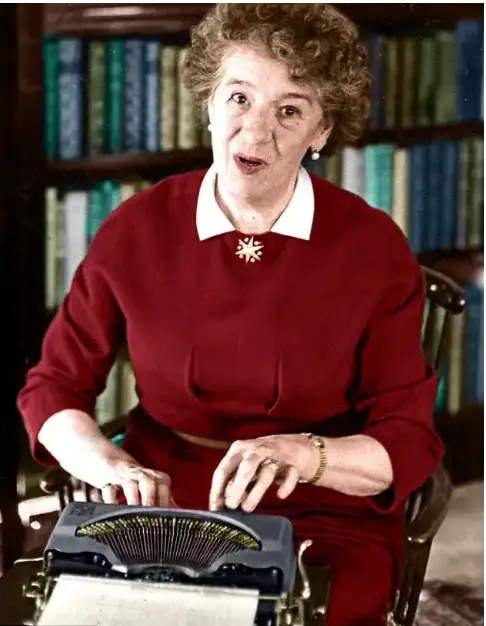If I knew Class 8 Modern English Manipur Board
In the enchanting poem “If I Knew” by Enid Blyton, the author beautifully envisions a world where joy can be unlocked and sorrows banished. If given the chance, she would open a magical box of smiles and spread them across the land and sea, lighting up children’s faces everywhere. Simultaneously, she dreams of gathering all frowns and sorrows, locking them away, and casting them into the ocean’s depths. This blog explores the poem, offering a comprehensive Class 8 English solution for BOSEM students, ensuring you grasp the profound simplicity and heartfelt message Blyton conveys.
Chapter Name: If I knew
Subject: Modern English
Lesson: 12
Class: 8
Board: Board Of Secondary Education Manipur (BOSEM/BSEM)
Contents: About the poet, summary of the poem, a short biography, Questions and Answers
Table of Contents
ABOUT THE POET:
Enid Blyton (11 August 1897 – 28 November 1968) was a prolific and highly popular British author of stories, poems, plays, and educational books for children. Her books are still enormously popular and have been translated into 90 languages. She wrote on a wide range of topics including education, natural history, fantasy, mystery, and biblical narratives and is best remembered today for her ‘Noddy’, ‘The Famous Five’, ‘Malory Towers’, and ‘The Secret Seven Series’.
SUMMARY OF THE POEM “If I knew”
The poem, “If I Knew” is a very simple yet very beautiful poem by Enid Blyton. The author, through this poem, says that if she knew that there were smiles that could be found in a box, then she would do her best to open the box and spread all those smiles on lands, seas, etc. No matter how large the key or strong the bolt, she would try hard to open it. She would send the smiles out in all directions, then over the land and sea and let the smiles dazzle on children’s faces.
At the same time, she would like to collect all the frowns and sorrows from everyone and also from the children’s faces, from the nursery to the children in the street. She would like to pack them in a large box, lock it up with a big monster key, and hire a giant to throw it into the depths of the ocean.

A Short Biography of Enid Blyton
Early Life and Education
Born: August 11, 1897, in East Dulwich, London.
Parents: Thomas Carey Blyton and Theresa Mary Harrison Blyton.
Siblings: Eldest of three children.
Schooling: Attended St. Christopher’s School in Beckenham.
Interests: Reading, writing, music, and sports.
Training: Trained as a teacher at Ipswich High School.
Career Beginnings
Early Jobs: Worked as a governess and teacher.
Writing: Submitted works to magazines and publications in her spare time.
First Publication: “Child Whispers” (1922), a collection of poems.
Rise to Fame
First Novel: “The Enid Blyton Book of Brownies” (1926).
Subsequent Works: “Adventures of the Wishing-Chair” (1937) and “The Enchanted Wood” (1939).
Major Works and Series
Noddy Series (1949): Stories about a little wooden boy in Toyland.
The Famous Five Series (1942): Adventures of Julian, Dick, Anne, George, and Timmy the dog.
The Secret Seven Series (1949): Tales of a secret society of children solving mysteries.
Malory Towers and St. Clare’s Series: Stories set in boarding schools.
Themes and Writing Style
Characteristics: Simplicity, imaginative plots, and moral lessons.
Common Themes: Friendship, bravery, and the triumph of good over evil.
Appeal: Writing for different age groups contributed to widespread popularity.
Criticism and Controversy
Criticisms: Accusations of stereotypes and lack of literary merit.
Scrutiny: Modern analysis of gender roles and social class portrayal.
Personal Life
First Marriage: Major Hugh Alexander Pollock (1924).
Children: Two daughters, Gillian and Imogen.
Divorce: 1942.
Second Marriage: Kenneth Fraser Darrell Waters, a London surgeon (1943).
Family Relations: Periods of estrangement from her family.
Dedication: Remained devoted to her writing.
Legacy
Death: November 28, 1968, in Hampstead, London.
Continued Popularity: Books adapted into television series, films, and stage productions.
Impact: Left an indelible mark on children’s literature.
BOSEM solutions for class 8 English chapter 12: If I knew
i) What would the poet do if she were to find the box where smiles were kept?
Ans: If she were to find the box where smiles were kept, she would do her best to open the box and spread all those smiles on lands, seas, etc. No matter how large the key or strong the bolt, she would try hard to open it.
ii) Where would the poet scatter the smiles and why?
Ans: The poet would scatter the smiles and let them dazzle on the children’s faces so that they might hold them fast for many days.
iii) Where would the poet gather all the frowns in the world?
Ans: The poet would gather all the frowns in the world from everyone and also from the children’s faces, from the nursery to the children in the street.
iv) After gathering the frowns, what would the poet do?
Ans: After gathering the frowns, the poet would pack them in a large box, lock it up with a big monster key, and hire a giant to throw the box into the depths of the ocean.
v) Write a few sentences on what the poet thinks about smiles and frowns.
Ans: A smile in any form is a good sign, and a simple smile can make someone’s day. Smiles signify happiness, joy, good news, and love. The poet in this poem expresses her desire to make everyone happy. She loves to see smiles on the faces of children. On the other hand, she doesn’t like the sorrows and sufferings of people. Frowns indicate sadness and worry. She wants to collect all the frowns from everyone and also from the children’s faces and pack them and throw them into the depths of the ocean.
FAQs
What is the central theme of Enid Blyton’s poem “If I Knew”?
The poem revolves around the idea of spreading smiles and banishing sorrows. Enid Blyton imagines a scenario where she would open a box of smiles to light up children’s faces worldwide, while also locking away frowns and sorrows.
How does Enid Blyton depict the concept of spreading smiles in “If I Knew”?
Enid Blyton metaphorically describes spreading smiles as a magical act of opening a box filled with smiles and letting them dazzle across lands and seas, reaching children everywhere.
What does Enid Blyton wish to do with frowns and sorrows in the poem “If I Knew”?
Enid Blyton expresses her desire to collect all frowns and sorrows, pack them in a large box, lock it with a monster key, and throw it into the depths of the ocean, symbolizing the removal of sadness from people’s lives.
What are the benefits of studying “If I Knew” in Class 8 Modern English under BOSEM?
Studying “If I Knew” helps students develop critical thinking skills by analyzing metaphors and symbolism. It also encourages empathy and understanding of complex emotions, making it a valuable part of the Class 8 Modern English syllabus under BOSEM.




